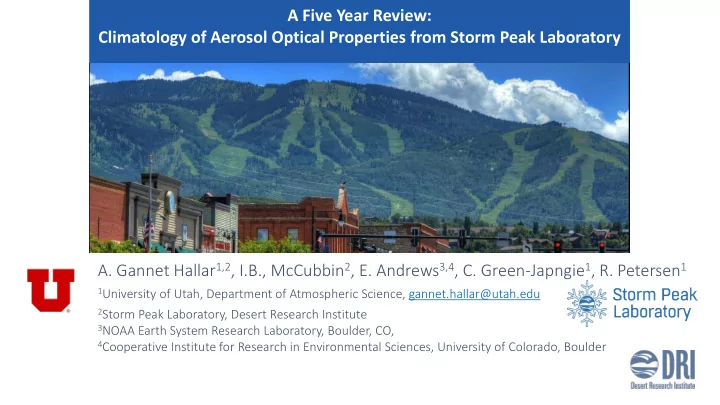

A Five Year Review: Climatology of Aerosol Optical Properties from Storm Peak Laboratory A. Gannet Hallar 1,2 , I.B., McCubbin 2 , E. Andrews 3,4 , C. Green-Japngie 1 , R. Petersen 1 1 University of Utah, Department of Atmospheric Science, gannet.hallar@utah.edu 2 Storm Peak Laboratory, Desert Research Institute 3 NOAA Earth System Research Laboratory, Boulder, CO, 4 Cooperative Institute for Research in Environmental Sciences, University of Colorado, Boulder
Located on Steamboat Springs Ski Resort Elevation: 3220 m Pressure: ~ 690 mb In cloud ~25% of time in winter Mixed Phase Clouds 9 Person Bunkhouse, Full Kitchen Facility and Guest Instruments Wet Chemistry Lab 2011 Established as GMD Aerosol Group and WMO Global Atmospheric Watch Regional Station Annual Site visits included Calibration and Improvements DRI Long Term Instrumentation: CPC, UCPC, PSAP, CLAP, Neph SMPS, APS, CCN-C UV/VIS MFRSR, MET NCAR CO2 O 3 , SO 2 , NO X SSP-100, CIP, PIP
SPL Sci SPL Science ce F Framewor ork Framework k 2006 Climate Change 2012 Aerosols Wildfires 2015 Dust Events Water (Drought)
Summer fire signal strong • in both in situ and AOD Spring dust signal weaker • in situ than AOD Work enabled by cloud • screening algorithm & student mentoring program with NOAA GMD Used α>1.3 to separate combustion sources from dust (Clarke and Kapustin, 2010; Science ) Radiation Group.
Link between Aerosol Loading and Fire Area • GCMs predicted a fire area increase of 2.69 times • Increasing summer OC by 46% by 2050 • From the data presented we expect an increase in: • OC of 24±3% and 34±3% for Southern Rockies & Wasatch/Uinta Mts. by 2050
SPL Sci SPL Science ce F Framewor ork Framework k Climate Change Challenges with Dust: Coarse Mode Sampling Aerosols Distinction between long range transport and local sources Wildfires Dust Events Water (Drought)
New Standard Ground Based Aerosol Inlet and Sampling Manifold System: Initial Funding from NSF, and now supported by USTAR. Designed in close Collaboration with NOAA Aerosol Group (J. Ogren) Design Simulations Manufacturing (BMI) Installation Comparison to Prior System Wind Tunnel Verification Completed!
Seasonality of Aerosols at SPL 2011 – 2016 GMD system allowing continuous measurements Confirms clear seasonality of dust in spring and fire signal in summer Expands the climatology of dust events from the prior intermittent APS data via Nephelometer
Increase Accessibility to SPL Data due to GMD Use of SPL Aerosol Concentration Data (from 1998-2017) after inputting into the GMD Aerosol database in 2012 Evaluation of Nucleation Parameterization Trend in Aerosol Scattering Makkonen , R., et al. (2014), Evaluation of Aerosol Number Concentrations in NorESM with Improved Nucleation Parameterization, Atmos. Chem. Phys., 14.10, 5127 - 5152. Yu, F., G. Luo, A. G. Hallar (2016), Vertical Profiles and Seasonal Variations of Key Parameters Controlling Particle Formation and Growth at Storm Peak Laboratory, Aerosol and Air Quality Research , 16(3), 900- 908, doi:10.4209/aaqr.2015.05.0341 Yu, F., et al. (2015), Spring and Summer Contrast in New Particle Formation Over Nine Forest Areas in North America, Atmos. Chemistry and Physics , acp-2015- 453. Yu, F. and A. G. Hallar (2014), Difference in Particle Formation at a Mountain-top Location During the Spring and Summer: Implications for the Role of Sulfuric Acid and Organics in Nucleation, J. of Geophysical Research, 119, 21, 12,246 12,255. Trend Analysis: Collaud Coen et al., 2013 Asmi , A. et al., (2013), Aerosol Decadal Trends – Part 2: In-situ Aerosol Particle Number Concentrations at GAW and ACTRIS Stations, Atmos. Chem. Phys., 13, 895 -916, Acknowledgements to Derek Hageman doi:10.5194/acp -13-895- 2013.
Conclusions 2011 Storm Peak Lab became GMD Regional Aerosol Station Improved existing station measurements: CPC, UCPC, Size distribution, CCN • Added Aerosol Optical properties to SPL • Resulted in regular calibration & standard QA/QC procedures • GMD provided critical input for the design, build, installation and verification of new aerosol inlet • GMD database allowed for all present and past data from SPL to become part of WMO record • Resulted in more publications • Allowed for data to be used in validating GCMs • Collaboration with GMD Radiation Group has allowed for: AOD product from SPL • Provided technical assistance with installation of MFRSR at the U. of Utah • Acknowledgements Storm Peak Laboratory/DRI: Doug Lowenthal , Melanie Wetzel, P. Tyson Atkins, Randy Borys, Joe Messina USDA/CSU UV- B Monitoring & Research Program NOAA GMD John Ogren, Betsy Andrews, Derek Hagman, Pat Sheridan, Joe Michalsky
Clear Impact of dust at surface in Spring Suggest Local Sources Climatology of dust using Nephelometer and APS in preparation (A. Lambert)
Recommend
More recommend